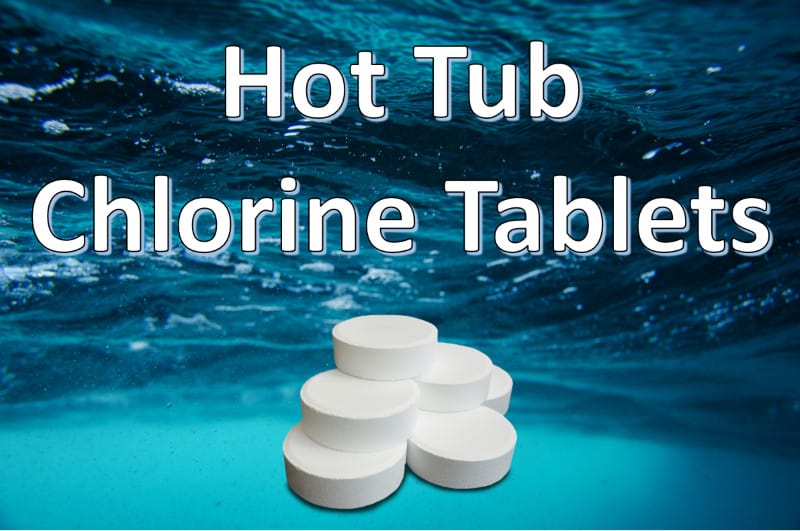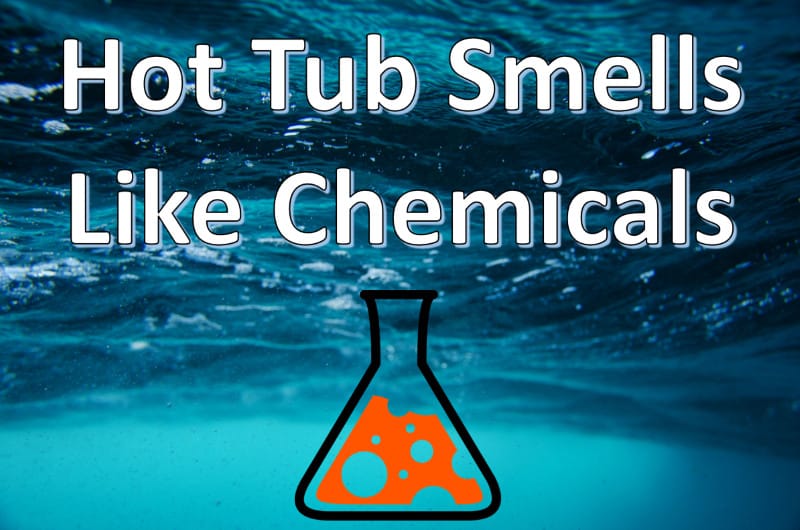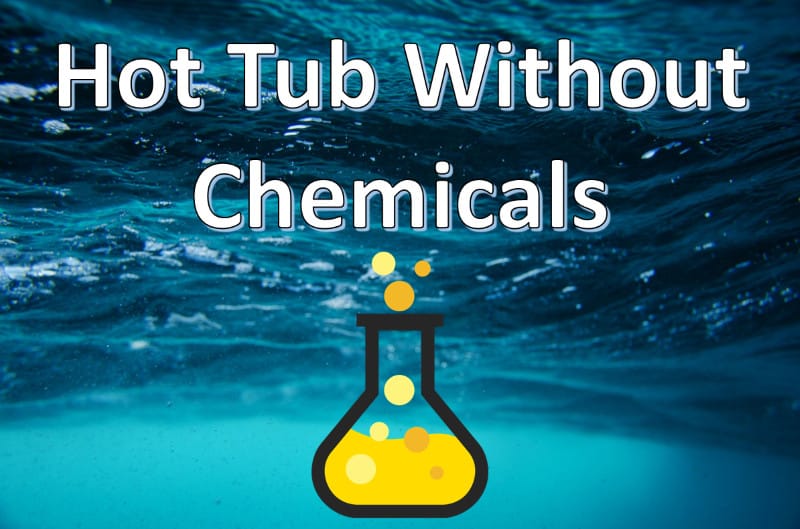What is oxidizer for hot tubs?
An oxidizer is a chemical compound that causes the loss of electrons on impurities such as organic material. As a result, it hastens their breakdown rate with the use of sanitizers. Oxidizers come in various forms and compositions, with some being granular, some liquid chlorine, and others non-chlorine salts.
Stop wasting time and money with hot tub maintenance and confusing water chemistry! The Hot Tub Handbook and Video Course will help keep your hot tub balanced, sanitized, and crystal clear all the time.
Check out my list of high-quality hot tub products to help keep your hot tub clean and running great all year long!
My recommended product to help you test your hot tub or pool water for accurate pH, alkalinity, bromine, and chlorine readings is the AquaCheck Trutest Digital Reader.
There is so much that happens in a hot tub, including deposition of the oils, shampoos, dead skins, and sweat.
While Chlorine will kill bacteria from the hot tub, you will need an appropriate oxidizer to break down these organic matters.
The purpose of this article is to explain the meaning of a hot tub oxidizer and its purpose.
I will explain the difference between the oxidizer and a shock and clarify what differentiates the two from a sanitizer.
By the end of this article, you will be able to tell when and why you require an oxidizer besides sanitizers. Keep reading to find out.
Let’s get started!
What Is Oxidizer For Hot Tubs?
An oxidizer is a chemical compound that causes the loss of electrons on impurities. As a result, it hastens their rate of breakdown. Oxidizers come in various forms and compositions, with some being granular, some liquid chlorine, and others non-chlorine salts.
Each of these forms is compatible with specific types of hot tubs, and it is always important to check with the manufacturer on the oxidizer you require to use with your specific hot tub model.
Many people do not understand what oxidizers for hot tubs mean. They are chemical compounds responsible for breaking down the organic compounds and oils in the hot tub water in the simplest terms.
The breakdown of organic in the hot tub increases the efficiency of the sanitizers, ensuring that the water stays clean and fresh for longer durations.
Oxidation can be done by directly adding an appropriate chemical into the water, but an Ozonator could also be used.
Sanitizing your hot tub is sufficient for most cases to maintain comfort and cleanliness.
Is Hot Tub Oxidizer The Same As Shock?
Some people use the term shocking when they mean oxidizing. Technically speaking, shocking is the same as oxidation. It is the application of the Chlorine or nonchlorine-based shock to the hot tub water. Shocking aims to break down unwanted organic matter, kill bacteria and remove contaminants.
Consequently, your hot tub water becomes clean and safe for bathing.
A shock treatment is usually like mega sanitization on the hot tub. You can use Chlorine or non-chlorine-based shock with your hot. But the chlorine shock is the most recommended because it will break down the organic matter and kill bacteria.
When you shock a hot tub, the actions include removal, eradication, and reactivation. Shocking the hot tub eliminates the organic matter responsible for clouding.
The inevitable bather load causes dead skin, sweat, and other matters that reduce the water quality, so shocking becomes necessary.
Another shocking essence is killing Bromamides and Chloramines, although I will discuss this in detail in the next section.
When you shock the hot tub, bacteria and other microorganisms are eliminated. The bacteria exposure results from prolonged exposure to the sunlight; they can also accumulate due to the failure to use the hot tub for long.
Whichever the case, a biofilm might start forming and affect your hot tub’s water clarity. Some bacteria can cause illness to the bathers; thus, the need for regular shocking.
I recommended Leisure Time Non-Chlorine Shock.
I recommended SpaGuard Enhanced Shock for dichlor chlorine shock.
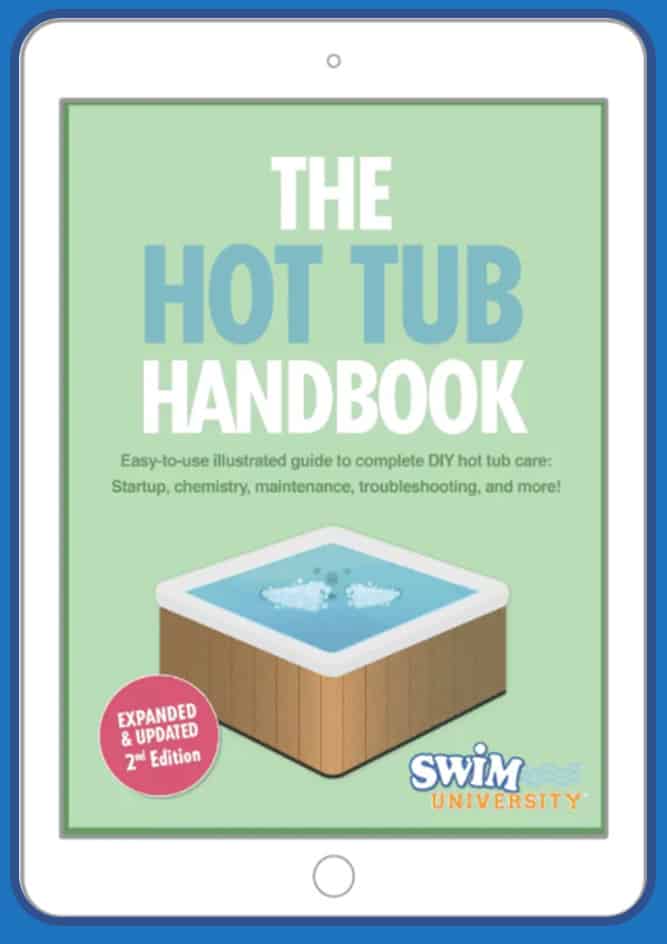
Stop wasting time and money with hot tub maintenance and confusing water chemistry! Get Instant access to this easy-to-use book and video course so you can spend less time cleaning and more time soaking.
Learn MoreOxidizer Removes Chloramines And Bromamines
The primary role is to remove organic matter and oils from hot tub water.
But it is always a challenge because we add more of the waste every time we are soaked. It would be best if you shocked your hot tub from time to time to ensure that you eradicate the traces of these matters.
But there are other forms of waste besides what we bring from our body into the pool. After the Chlorine and bromides have been used, they form chloramines and bromides that get deposited into the hot tub.
It is common to wonder whether the shocking will help with their eradiation just like it does for organic matters.
From extensive research, I found that chloramines and bromides are bad for the bathers and the hot tub. as such, they should be removed from time to time to prevent excessive accumulation into the hot tub.
They can show your test strip that your water contains higher than the present dosages of Chlorine or bromine. In the real sense, the levels could be very low for the safety of the bathers.
Fortunately, shocking will help eliminate these wastes to detect the available chlorine levels accurately. Chloramines and bromamides are formed by organic wastes of ammonia and nitrogen. That is why they can be eliminated by shocking.
Their presence produces a foul odor, especially Chlorine, if chloramines are concentrated in the hot tub.
In addition, the compounds might harbor algae growth, cause cloudiness in the water and affect the health of the bathers. Shocking helps eliminate the bad smell by removing all the wastes.
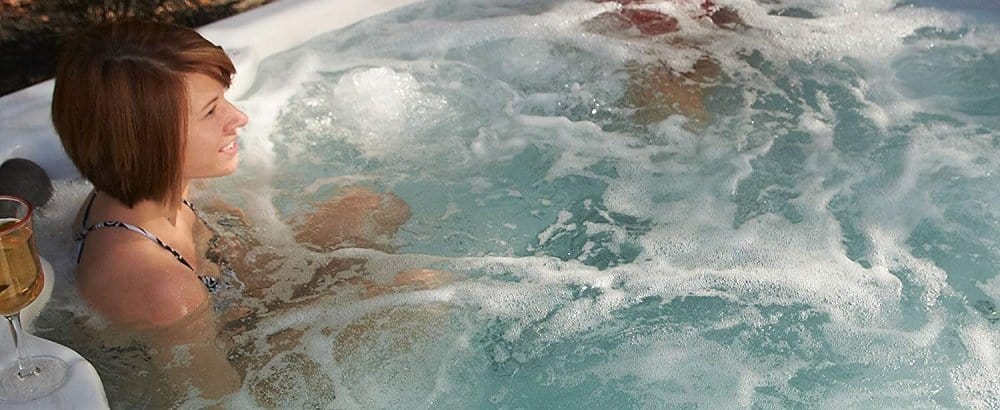
When Should I Shock My Hot Tub?
You should shock your hot tub weekly. Doing so will prevent the accumulation of dirt or the build-up of bacteria in your system. In addition, it will break down the organic matter that enters the hot tub with bathers.
Many bathers will increase the dirt and organic matter deposited in the hot tub over a shorter period.
Therefore, it would be best to shock the hot tub at this interval to ensure that the water sanitizer is always reactive to eliminate harmful bacteria effectively.
The first step in shocking your hot tub is to remove the cover to allow sufficient entry of oxygen into the water. The next thing is to ascertain that pH levels are within the limits of 7.2 and 7.6 if you use the chlorine sanitizer and 7.2 to 7.4 for the bromine. Remember that you can use the two sanitizers interchangeably because they all work perfectly in doing the same thing.
Turn on the jets while the water is circulating. Then add about ½ oz of the non-chlorine shock for every 400 gallons of water or 1¼ oz of the chlorine-based shock for the same water volume. After adding the shock, leave the hot tub uncovered for about 20 minutes.
If you are unsure of the capacity of your hot tub, consult your manual for clarification.
What’s The Difference Between An Oxidizer And Sanitizer?
An oxidizer is different from a sanitizer. A sanitizer destroys disease-causing microorganisms. Sanitizing the water is about removing bacteria from the hot tub. On the other hand, an oxidizer shocks the hot tub without necessarily destroying the bacteria but the organic matter.
An oxidizer uses oxygen in consuming the organic matter brought into the hot tub by the bathers. The oxidizer converts this organic matter into harmless gas and releases it into the atmosphere.
This is an entirely contrary task to sanitizers that kill bacteria and germs harm the soakers.
Oxidizers help remove bacterial and non-bacterial contaminants in the hot tub water, including dirt, algae, leaves, and oils. They also help convert chloramine into Chlorine if you use chlorine sanitizers with your hot tub.
If you are using bromine, the same case will happen. These conversions help ensure that the Chlorine or the bromine you had added in the hot tub is in an active form.
The bottom line in shocking and sanitizing your hot tub is to maintain the cleanliness and clarity of the hot tub water.
How Chlorine Works Compared To Oxidizers
Chlorine is a chemical that kills bacteria through a chemical reaction. When added to the water, the chemical reaction kills the bacteria.
The dichlor granules latch on the algae and bacteria in the hot tub water, among other unwanted organisms. Chlorine breaks down the cell walls of the contaminants when in contact, rendering them weak and gradually useless.
The reaction between organics and dichlor creates a byproduct in the hot tub chemistry. The dichlor contains chloramines, otherwise called the total Chlorine.
Effective sanitization will require you to keep the chlorine levels between 2 and 5 ppm. If the total Chlorine exceeds the recommended levels and the hot tub chlorine is low, many chloramines will be left in water.
The build-up of the chloramines in hot tub water causes a chemical odor, which can be addressed by shocking with an appropriate agent like Chlorine.
You’d be surprised to learn that there are five different types of Chlorine: dichlor, calcium hypochlorite, sodium hypochlorite, lithium hypochlorite, and trichlor. Each of these compounds has a unique chemical composition and intended usage.
Chlorine is only a building block in each of the compounds. For example, sodium hypochlorite is a combination of sodium hydroxide and Chlorine. It is used as an antimicrobial and disinfectant and goes by the common name of bleach.
On the contrary, trichlor and dichlor are stabilized with cyanuric acid, protecting sunlight. The acid is added to make these two compounds ideal with outdoor hot tubs and pools.
An important point to bear in mind is the need to use Chlorine intended for use in a hot tub. If you use pool chlorine, it might not be very effective for the hot tubs. Worst off, it might damage the components, so stick to the recommended products to avoid trouble.

Does Spa Oxidizer Lower Ph?
The spa oxidizer does not lower the pH of your hot tub water. Most of the shocking agents are non-chlorine, which is why they will rarely affect the pH readings. But there are also chlorine-based shocking agents. If you add these compounds in excessive quantities, they might lower the pH levels of your hot tub water.
When added to the hot tub, oxidizers consume foreign organic matter and release a harmless gas into the atmosphere. But it is good to note that oxidizers work best at a low pH.
I recommend testing the pH levels and making the necessary adjustments before you start shocking. The ideal pH should be in the range of 7.2 and 7.6 for the optimum efficacy of the shocking agent.
When added at a 7.3 pH reading, the shocking agent will be much more efficient in eliminating organic matter than when added at a pH of about 7.9.
But it’s essential to know some of the causes of a low pH in your hot tub. For example, the neutrality of your hot tub water is affected by the introduction of foreign matter in the water, like grass or minerals. Dust, body oils, and other organic matter can also affect the water chemistry and increase its acidity.
If you find your hot tub’s pH always low, the problem might be a natural contaminant affecting the water’s neutrality status.
For example, figure out whether you’re jumping into the hot tub after a hard workout or you’re walking over mulch or grass to get to the hot tub.
The treatment by your local municipal council could be the reason for the low pH on your hot tub water. For drinking safety, the water is usually expected to have a pH reading of between 6.5 and 8.5.
If water is supplied with the pH at a lower margin, it will be too acidic for the hot tub.
Other causes of low pH in a hot tub include increased bather load and the addition of too much pH down a chemical to balance the hot tub water chemistry.
My recommended product to raise pH in hot tubs is Spa Essentials pH increaser Granules.
Should I Use A Chlorine Shock Or A Non-Chlorine Shock?
Different people will choose either of the products based on real reasons because each has a unique advantage. But some, especially the new hot tub users, cannot decide what to use in cleaning their hot tubs between the Chlorine and non-chlorine shocks.
I would recommend bromine as a sanitizer and a non-chlorine shock. These compounds hold up better in hot water than chlorine-based products. Besides, they have less odor and are usually easy on the skin.
Nevertheless, this does not mean that you cannot use chlorine sanitizers because the comparison between the two can make you prefer Chlorine over bromine. For example, chlorine granules are cheaper than non-chlorine shock.
But both of the products have relatively equal strength in cleaning the hot tub. At the same time, Chlorine dissolves faster to sanitize and oxidize diseases and organic contaminants. When added to the hot tub and neutral pH, it also produces a chemical odor.
On the contrary, the non-chlorine shocks have a low pH and dissolve quickly. Besides, experts hail it as an excellent sanitizer and oxidizer. Contrary to the chlorine shock, you can use the hot tub immediately after adding the bromine shock.
In about 20 minutes, the hot tub will be ready to use. Although it does not produce odor upon addition into the hot tub, it is more expensive than the chlorine sanitizers.
These facts should help you weigh and choose your preferred method of shocking your hot tub.
Can You Shock A Hot Tub Too Much?
Yes, you can shock a hot tub too much by adding an excessing amount of the shocking agent. You can do this accidentally or when you’re not careful enough. And it could happen with other chemicals as well and not just the hot tub shocks.
My advice would be to read through the label of your shock carefully before you start using it. Since different shocks have different strengths, reading the label will ensure that you’ll neither overdose nor underdose your hot tub. This will be possible if you carefully measure the shock dosage. You will either overdose or underdose if you miss even by a ½ ounce of the requirement.
An important point to bear in mind is that there is never a set limit which you can take to use the hot tub after shocking. Anywhere from 20 minutes to 24 hours would be sufficient.
The longer wait would be practical if you shock your hot tub too much. Just keep checking the chlorine levels from time to time until you will determine that its levels have stabilized.
Consider Using a Water Care Monitor
Monitoring the health of your hot tub can often be challenging if you are not testing the water on a regular basis. This can also be a problem if you go on holiday or you are unable to take care of your hot tub due to mobility issues.
A test system I highly recommend is the Exact Industrial Test System. This system is great for hot tubs and pools and gives your a highly accurate digital readout of your water chemistry compared to other methods.
The pHin Smart Water Care Monitor for pools, hot tubs, and inflatable spas continuously tests the water and alerts you when to add chemicals with the integrated mobile app.
This water care monitor also takes constant readings of the temperature inside your hot tub. This will give you peace of mind while away from your spa.
The mobile app will inform you when to add chemicals such as chlorine, and how much chemical is recommended. This is done by entering your hot tub or pool’s unique dimensions.
This mobile app is great if you’re wondering “does chlorine raise pH in a hot tub?” sometimes it’s not always clear.
Simply scan the bar code of any chemical brand and the pHin app will calculate how much chemical is to be added to the water. Most products and brands are recognized by the application.
The pHin device will sample water more than 1000 times per week to give you an accurate reading compared to using test strips.
The pHin device works with different water types including chlorine, bromine, and saltwater hot tubs, swim spas, inflatable hot tubs, and pools.
This unique device comes with a lifetime warranty to ensure your water remains clear and ready for you to use at all times.
What Is Oxidizer For Hot Tubs: Conclusion
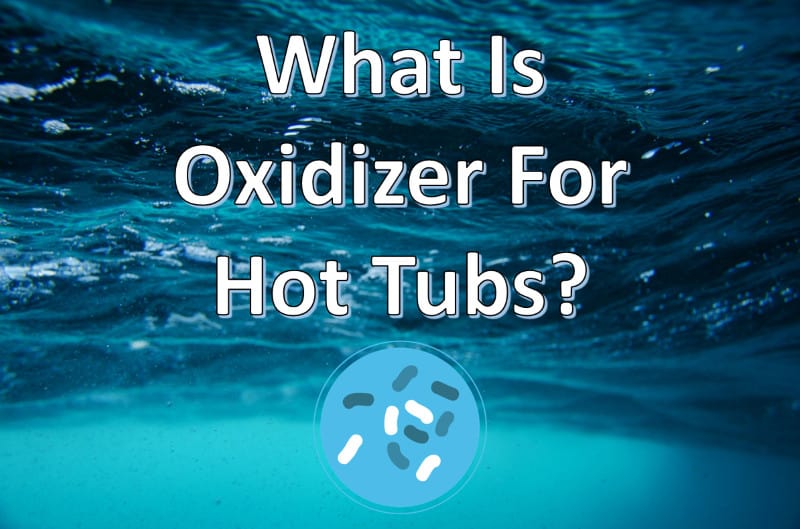
A hot tub oxidizer is a chemical compound that helps break down organic matter from the bather load and other foreign contaminants in the hot tub water.
It also helps eliminate bromamides and chloramines so that you can detect the correct levels of Chlorine or bromine in the hot tub. Unlike oxidizers, sanitizers help kill bacteria and other living organisms in the water.
Shocking agents can be chlorine-based or non-chlorine-based, and each compound has its benefits and limitations.
Oxidizers are shocking agents. Your manufacturer’s recommendations should determine your choice of the appropriate oxidizing agent. The advisable interval for shocking your hot tub should be every week.
After the Chlorine has stabilized, your hot tub should be ready to use. However, it can be used almost immediately if you’re not using Chlorine-based shocking agents.
I hope you found this article on what is oxidizers for hot tubs helpful.
Thanks for visiting spatoolkit.com
James Brockbank

Stop wasting time and money with hot tub maintenance and confusing water chemistry! Get Instant access to this easy-to-use book and video course so you can spend less time cleaning and more time soaking.
Learn More






